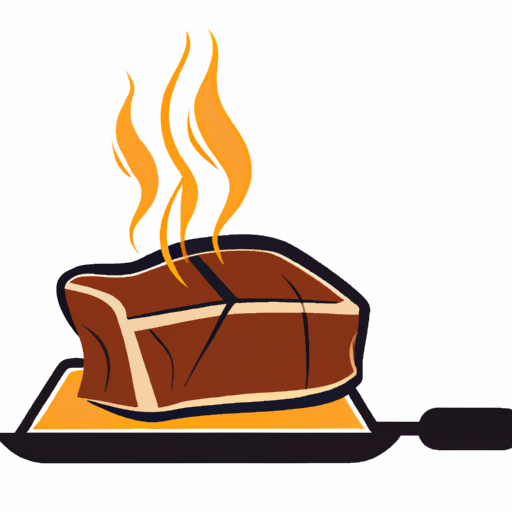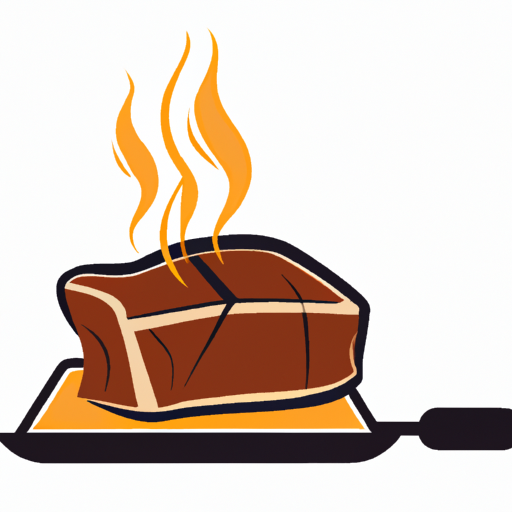Have you ever struggled with cooking the perfect brisket? Look no further! With “Perfectly Cooked Brisket: Mastering the Cooking Times,” you can say goodbye to overcooked or undercooked briskets. This innovative product provides you with precise cooking times for a perfectly tender and juicy brisket every time. Say hello to your new go-to guide for mastering the art of brisket cooking!

Choosing the Right Brisket
When it comes to cooking brisket, selecting the right cut of meat is crucial. Brisket is typically divided into three grades: USDA Prime, USDA Choice, and USDA Select. USDA Prime is the highest grade and is known for its exceptional marbling, which adds flavor and tenderness to the meat. USDA Choice is also a good option, with slightly less marbling but still offering great taste. USDA Select is the leanest grade and tends to be less tender than the higher grades.
Consider the level of marbling you prefer and choose the grade accordingly. Keep in mind that Prime and Choice briskets may be more expensive than Select, but the added flavor and tenderness are well worth it for a truly delicious brisket.
Wet-Aged vs. Dry-Aged Brisket
Another important factor to consider when selecting a brisket is whether it has been wet-aged or dry-aged. Wet-aging refers to the process of vacuum-sealing the meat and allowing it to age in its own juices. This method helps tenderize the meat and enhance its flavor. Dry-aging, on the other hand, involves hanging the meat in a controlled environment and allowing it to age for a period of time. This process intensifies the flavor and can result in a more pronounced beefy taste.
Both wet-aged and dry-aged briskets can produce excellent results, so it ultimately comes down to personal preference. Wet-aged briskets tend to be more readily available, while dry-aged briskets may be harder to find and come at a higher price point. Experiment with both to find your preferred flavor profile.
Selecting the Size of Brisket
The size of the brisket you choose will depend on the number of people you plan to serve and the cooking method you intend to use. A whole packer brisket, which includes both the flat and the point, is generally around 12-16 pounds. This large cut of meat can feed a crowd and is great for low and slow cooking methods, such as smoking.
If you’re cooking for a smaller group or prefer a more manageable size, you can opt for a trimmed brisket flat. These are usually around 6-8 pounds and work well for grilling or roasting. Consider the capacity of your smoker or grill when deciding on the size of the brisket, as it should fit comfortably without overcrowding.
Prepping the Brisket
Once you’ve chosen the perfect brisket, it’s time to prepare it for cooking. Prepping the brisket involves trimming the fat, seasoning the meat, and allowing it to rest before cooking.
Trimming the Fat
Brisket is a naturally fatty cut of meat, and while some fat adds flavor and moisture, excessive fat can prevent the meat from properly absorbing the seasoning and smoke. Trim the fat to about ¼ inch thickness, making sure to leave some fat for flavor. Remove any hard fat or silver skin to ensure a more even cook and better texture.
Seasoning the Brisket
Seasoning plays a crucial role in enhancing the flavor of the brisket. There are countless rubs and marinades to choose from, but a classic combo of kosher salt, black pepper, and garlic powder is a tried and true option. Apply the seasoning generously, making sure to cover all sides of the meat. Allow the brisket to sit at room temperature for at least 30 minutes to allow the flavors to penetrate the meat.
Allowing the Brisket to Rest
Before firing up the smoker or grill, it’s important to let the seasoned brisket rest. This allows the meat to come to room temperature, ensuring more even cooking. Additionally, resting the meat allows the seasoning to fully penetrate the meat, resulting in a more flavorful end product. Aim for a resting time of at least 30 minutes, but longer resting times of up to two hours can further enhance the tenderness and flavor.

Setting up the Smoker or Grill
The cooking equipment you choose can greatly impact the flavor and tenderness of your brisket. Whether you opt for a smoker or a grill, setting it up properly is key to a successful cook.
Selecting the Fuel
When it comes to fuel options, you have a few choices. A charcoal smoker or grill offers a traditional flavor profile and can reach high temperatures for a great sear. Wood pellet smokers provide a convenient option, as they offer a wide range of temperature control and impart a subtle smoky flavor. If you prefer a gas grill, make sure it has enough power to maintain a consistent temperature throughout the cooking process.
Preheating the Smoker or Grill
Before placing the brisket on the cooking surface, it’s important to preheat the smoker or grill. This ensures a consistent cooking temperature from the start and helps achieve that beautiful smoke ring and caramelized crust. Follow the manufacturer’s instructions for preheating and aim for a cooking temperature of around 225-250°F for low and slow cooking methods.
Adding Smoke Flavor
If you’re using a smoker, adding smoke flavor is an essential step in achieving a delicious brisket. Wood chips or chunks are commonly used to create smoke, with options such as hickory, mesquite, apple, or cherry. Soak the wood chips in water for about 30 minutes before placing them in the smoker box or directly on the coals. This helps create a steady stream of smoke throughout the cooking process. Experiment with different wood flavors to find your preferred smoky profile.
Low and Slow Cooking
Low and slow is the name of the game when cooking brisket. This method involves cooking the meat at a low temperature over an extended period, allowing the collagen in the meat to break down and transform into melt-in-your-mouth tenderness.
Maintaining the Temperature
Consistently maintaining the cooking temperature throughout the entire cooking process is crucial for a tender brisket. Use a reliable thermometer to monitor the temperature and make adjustments as needed. Fluctuations in temperature can result in an uneven and less desirable end product. Invest in a reliable thermometer that can provide accurate readings throughout the cook.
Positioning the Brisket in the Smoker
Properly positioning the brisket in the smoker is important for even cooking. Place the brisket fat side up to allow the fat to render down and baste the meat as it cooks. This fat cap acts as a protective layer, preventing the meat from drying out and ensuring a moist end result. If you’re cooking multiple briskets, leave enough space between them to allow for proper airflow and even cooking.
Wrapping the Brisket
At some point during the cooking process, you may choose to wrap the brisket to help tenderize the meat and prevent it from drying out. This technique, known as the Texas Crutch, involves tightly wrapping the brisket in foil or butcher paper. Wrapping helps retain moisture and accelerates the cooking process by creating a steamy environment around the meat. Keep in mind that this method can soften the bark or crust, so consider your preference when deciding whether to wrap.
Determining Internal Temperature
To achieve the perfect level of doneness, it’s important to monitor the internal temperature of the brisket. An accurate probe thermometer is an essential tool for this step.
Inserting the Probe Thermometer
To check the internal temperature, insert the probe thermometer into the thickest part of the brisket, avoiding contact with bone or fat. Make sure the thermometer is inserted deep enough to get an accurate reading. Keep in mind that the temperature may differ in different areas of the brisket, so it’s a good idea to test multiple spots to get an overall reading.
Target Temperature for Different Levels of Doneness
The desired internal temperature can vary depending on personal preference. For a tender and juicy brisket, aim for an internal temperature of around 195-203°F. At this temperature range, the collagen has fully broken down, resulting in a melt-in-your-mouth texture. If you prefer a firmer texture, you can remove the brisket from the heat at a slightly lower temperature, around 185-195°F.
Understanding the Stall
During the cooking process, you may experience a phenomenon known as the “stall.” The stall occurs when the internal temperature of the brisket plateaus, often around 160-170°F. This can last for several hours, as the moisture on the surface evaporates, cooling the meat and slowing down the cooking process. Don’t panic if you encounter the stall – it’s a normal part of the cooking process. Simply be patient, as the temperature will eventually start to rise again.
Cooking Time Guide
Cooking a brisket is a time-consuming process, and estimating the cooking time is essential for planning. However, keep in mind that cooking times can vary depending on various factors, so it’s important to use these estimates as a guideline.
Cooking Time Estimates
For low and slow cooking methods at a temperature of around 225-250°F, you can generally estimate a cooking time of around 60-90 minutes per pound of meat. This means a 12-pound brisket could take anywhere from 12 to 18 hours to cook. Keep in mind that these are rough estimates, and the actual cooking time can vary depending on the many factors involved.
Factors Affecting Cooking Time
Several factors can affect the cooking time of your brisket. The thickness of the meat, the consistency of the cooking temperature, the ambient temperature, and the size of your smoker or grill can all contribute to variations in cooking time. It’s important to monitor the internal temperature of the brisket rather than rely solely on cooking time to determine doneness.
Using the Texas Crutch
If you’re running short on time or want to accelerate the cooking process, you can use the Texas Crutch method mentioned earlier. By wrapping the brisket in foil or butcher paper, you create a steamy environment that helps speed up the breakdown of collagen and reduces the overall cooking time. However, keep in mind that this method can soften the crust or bark, so if you prefer a crispier exterior, it’s best to reserve the Texas Crutch for emergencies only.
Resting the Brisket
After investing so much time and effort into cooking the perfect brisket, it’s essential to allow it to rest before slicing and serving.
Why Resting is Important
Resting allows the juices within the brisket to redistribute, resulting in a more flavorful and tender end product. Cutting into a brisket immediately after cooking can cause the juices to escape and leave you with a drier brisket. Resting also helps the meat retain its heat, allowing you to serve it at the optimal temperature.
Duration of Resting
Aim to rest the brisket for at least 30 minutes to an hour, although longer resting times of up to two hours can yield even better results. After removing the brisket from the smoker or grill, tent it loosely with foil to keep it warm and prevent it from cooling too quickly. This resting period allows the meat to relax and reach its peak tenderness.
Storage and Reheating
If you have leftovers or want to prepare the brisket ahead of time, proper storage and reheating methods are crucial to maintain its quality. Once the brisket has rested, you can wrap it tightly in foil or plastic wrap and refrigerate it for up to three days. When reheating, make sure to do so slowly to prevent the meat from drying out. You can use the oven, a low heat on the grill, or even steam to gently warm the brisket without compromising its tenderness.
Slicing the Brisket
Slicing the brisket properly is just as important as cooking it to perfection. Follow these tips to ensure your slices are tender, juicy, and visually appealing.
Choosing the Right Knives
Investing in the right knives will make a world of difference when it comes to slicing brisket. A sharp slicing knife or a long, thin-bladed carving knife is ideal for achieving thin, even slices. Make sure the blade is long enough to cut through the width of the brisket, allowing you to maintain a clean, straight cut.
Slicing Techniques
When slicing the brisket, it’s crucial to cut against the grain. This means cutting perpendicular to the direction of the muscle fibers. Slicing against the grain helps break up the muscle fibers and ensures each bite is tender and easy to chew. Take your time and use smooth, even strokes to achieve consistent slices. If you’re unsure about the direction of the grain, look for the lines of connective tissue in the meat and cut across them.
Presentation Tips
The presentation of your brisket can elevate the dining experience and make your guests’ mouths water. Arrange the slices neatly on a platter, ensuring they overlap slightly. This not only looks visually appealing but also allows the slices to stay warm for longer. Consider garnishing the platter with fresh herbs or adding a drizzle of barbecue sauce for that extra touch of flavor and aesthetics.
Troubleshooting Common Issues
Even the most experienced pitmasters can face challenges when cooking brisket. Here are some common issues you might encounter and how to troubleshoot them.
Dry Brisket
If your brisket turns out dry, it could be due to cooking it for too long or at too high of a temperature. Overcooking can cause the meat to become dry and tough. To prevent this, monitor the internal temperature closely and remove the brisket from the heat once it reaches your desired level of doneness. Additionally, consider wrapping the brisket earlier in the cooking process to retain moisture.
Undercooked Brisket
Undercooked brisket can be disappointing, especially after investing so much time in the cooking process. If you find your brisket is undercooked, you can continue cooking it until it reaches your desired internal temperature. Make sure to monitor the temperature closely and adjust the cooking time accordingly. If you’re running short on time, you can wrap the brisket in foil or butcher paper to speed up the cooking process while still keeping it tender and flavorful.
Overcooked Brisket
Overcooked brisket can result in dry, mushy meat that lacks flavor. To avoid overcooking, monitor the internal temperature regularly and remove the brisket from the heat once it reaches your desired level of doneness. If you find that the brisket has been overcooked, you can try slicing it thinly against the grain to break up the fibers and make it more tender. Additionally, serving the brisket with a flavorful sauce or barbecue rub can help enhance the overall taste.
Brisket Recipe Ideas
Now that you’ve mastered the art of cooking brisket, it’s time to get creative with recipes. Here are a few ideas to try:
Traditional BBQ Brisket
For a classic, mouthwatering Texas-style barbecue brisket, season the meat with a rub of salt, black pepper, and paprika. Smoke it low and slow until it reaches your desired level of tenderness. Serve with tangy barbecue sauce and your favorite side dishes for a memorable meal.
Mexican-style Brisket Tacos
Take your brisket on a flavorful journey with Mexican-inspired tacos. Season the brisket with a blend of chili powder, cumin, coriander, and oregano for a bold and spicy taste. Slow-cook the seasoned brisket until it’s tender enough to shred. Serve the smoky, shredded brisket in warm tortillas with salsa, pickled onions, and fresh cilantro for a delicious fusion of flavors.
Asian-inspired Brisket Stir-Fry
Give your brisket an Asian twist by slicing it thinly and stir-frying it with a mix of soy sauce, ginger, garlic, and sesame oil. Add your favorite vegetables to the stir-fry, such as bell peppers, broccoli, and snap peas, for a colorful and nutritious meal. Serve over steamed rice or noodles for a satisfying and flavorful dish.
With these recipes, your culinary creativity can soar while still incorporating the mouthwatering flavors and tenderness that make brisket the ultimate crowd-pleaser.
In conclusion, cooking the perfect brisket is a labor of love that requires time, patience, and attention to detail. Whether you’re a seasoned pitmaster or a beginner, this comprehensive guide has provided you with the knowledge and techniques to achieve brisket perfection. From choosing the right cut and prepping the meat to cooking it low and slow, determining the internal temperature, and troubleshooting common issues, you now have all the tools necessary to embark on your brisket-cooking journey. So fire up the smoker or grill, grab your favorite seasoning, and get ready to impress your friends and family with delicious, mouthwatering brisket creations that will leave them asking for seconds.
